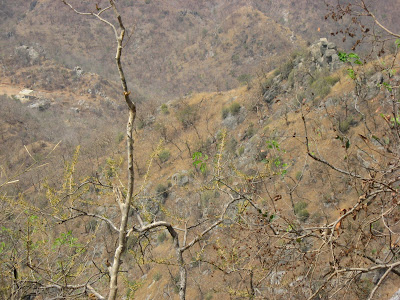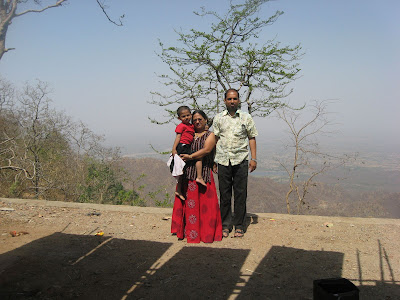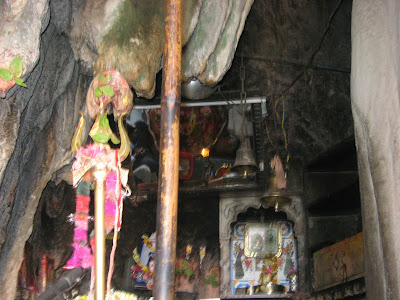The year was 1290 . A crowd had gathered around a clearing, where broken down pillars marked the presence of an ancient temple, now long gone. A young boy, just 14 years old, leaned against one of those pillars, deep in thought. Then, he began speaking, and the crowd fell silent, listening to his every word. He spoke without any notes, translating the Bhagavat Gita, from Sanskrit, which only the pundits knew, to the language everyone in the village knew and spoke – a variety of Prakrit which developed into the Marathi language. Even as he spoke, one of the men in the audience realized how momentous this event was, and how important this composition would be. He began writing down the words the young boy spoke, and this composition was named by its author and composer, the Bhavartha Deepika – the enlightening meaning (of the Bhagavat Gita). Now, the ancient, holy text, was no longer restricted to the pundits, but accessible to all, understood easily by them, composed as it was, in their...
It was Mohammed’s suggestion that we keep aside a day for the Parashuram Mahadeo temple. Mohammed was our jeep driver for the jungle safari. Since he seemed to know the area well, and agreed to take us there the next day, we agreed to take his advice, and, in retrospect, it is a good thing that we did!
We planned to leave by 9:00 AM, after an early breakfast, but Samhith didn’t wake up, and we didn’t want to spoil his holiday by waking him up, so it was past 10:30 that we finally left.
The Parashuram Mahadeo temple is a cave on a mountain, which is accessible from both, the foothills as well as the peak. When you approach the temple from Falna, there is a road leading up to the foothills, from where you have to climb up the mountain to reach the temple. From Kumbhalgarh, there is a road leading to the mountain peak, from where one has to walk down a path to the temple.

View from the peak- on the right, the saffron flag indicates the location of the temple, and on the left, the building seen is on the foothills, from where one starts the ascent, if one comes from Falna.
It is a rough path, which has steps in some portions. This path apparently was much worse till a few years back, when a generous patron donated money for improving the path. Most of the path is now smooth and railings have been constructed on the edges. This path is 1 ¼ Km long. We started our trek down the mountain around 11:30 PM. We were told to wear our slippers, as the path was rough, but just a few steps down, Samhith stepped on my feet, and my slipper broke. I continued the rest of the journey with bare feet, taking it to be a command from the Lord to come barefoot to the temple.

Here we are, at the peak of the mountain, from where we began our descent to the temple.
Normally, climbing down a mountain is supposed to be easy, but here, the path downhill is so steep, it was not in the least easy. I had to hold Samhith's hand all the time to prevent him from running and falling down, and, believe me, it took all my efforts to do so! If climbing down was like this, you can imagine what climbing up would have been like. By the time we started our climb uphill, it was past noon, the sun was right over our heads, shining as brightly as possible, heating up the road. The steep path was difficult to climb by itself, besides, I was barefoot, and I had blisters on my feet by the time I managed to reach the jeep. It took us a full two hours to get to the temple and back!

The cave temple of Parashuram Mahadeo
It is believed that Sage Parashuram came to this cave to meditate without any kind of disturbance. It was here that he was blessed by Lord Shiva. There is a Shivaling in this cave, called Parashuram Mahadeo, which is not manmade, but is supposed to have appeared, by itself. Right above the Shivaling, the rocks of the cave form a shape, which resembles a cow’s mouth (Go-mukh), from where water keeps dripping onto the Lingam. This water, it is said, is perennial, regardless of whether there have been rains or not. Moreover, it is believed that till about 75 years ago, it used to be milk dripping on the lingam. Gradually, the milk became watery until finally, about 50 years back, water started flowing. There is another shape in a corner, from which water sometimes drips, which resembles the udders of a cow. It is a local belief that if a childless couple prays to the Lord here, and if water from this portion drips on their hand, they beget a child soon. All in all, it is a very impressive temple, and I am very happy that I could make it here.

Inside the cave- the rocks seen above the trishul form the Gomukh
Though the temple is not very easily accessible, I believe that a large number of people visit the temple on special days, and there are good arrangements made for the pilgrims. In fact, they seem to have some wealthy patrons, who are willing to donate to improve the facilities, and in fact, arrangements are being made to construct dharamshalas, resting places, etc. For those interested in visiting the temple, there are shops just outside the temple, which sell everything from puja articles, from refreshments, to photos, books and even CDs about the temple. I have bought one of those CDs and shall try to put it online soon.
An interesting thing about this section of the mountain-side is that the smooth surface of the rocks is covered with beehives. That, and the multitudes of monkeys, who kept looking for food from the devotees, made the trek worthwhile for Samhith. He was scared of the monkeys, but was fascinated by them, and happily gave them ‘Chana’ which the shopkeeper provided. I wondered how he would manage the trek back up the hill, especially as I was in no state to carry him, but he proved my fears baseless, and made me proud by walking all the way, of course, resting every now and then!
We returned to the resort in time for lunch, but were too tired to go anywhere else after walking so much. Though we had walked only 2 ½ Km in all, it seemed like so much more because of the gradient of the road. But it was truly worth all the effort and the tiredness. This is a temple I will always remember, and encourage others to visit too…….
We planned to leave by 9:00 AM, after an early breakfast, but Samhith didn’t wake up, and we didn’t want to spoil his holiday by waking him up, so it was past 10:30 that we finally left.
The Parashuram Mahadeo temple is a cave on a mountain, which is accessible from both, the foothills as well as the peak. When you approach the temple from Falna, there is a road leading up to the foothills, from where you have to climb up the mountain to reach the temple. From Kumbhalgarh, there is a road leading to the mountain peak, from where one has to walk down a path to the temple.
View from the peak- on the right, the saffron flag indicates the location of the temple, and on the left, the building seen is on the foothills, from where one starts the ascent, if one comes from Falna.
It is a rough path, which has steps in some portions. This path apparently was much worse till a few years back, when a generous patron donated money for improving the path. Most of the path is now smooth and railings have been constructed on the edges. This path is 1 ¼ Km long. We started our trek down the mountain around 11:30 PM. We were told to wear our slippers, as the path was rough, but just a few steps down, Samhith stepped on my feet, and my slipper broke. I continued the rest of the journey with bare feet, taking it to be a command from the Lord to come barefoot to the temple.
Here we are, at the peak of the mountain, from where we began our descent to the temple.
Normally, climbing down a mountain is supposed to be easy, but here, the path downhill is so steep, it was not in the least easy. I had to hold Samhith's hand all the time to prevent him from running and falling down, and, believe me, it took all my efforts to do so! If climbing down was like this, you can imagine what climbing up would have been like. By the time we started our climb uphill, it was past noon, the sun was right over our heads, shining as brightly as possible, heating up the road. The steep path was difficult to climb by itself, besides, I was barefoot, and I had blisters on my feet by the time I managed to reach the jeep. It took us a full two hours to get to the temple and back!
The cave temple of Parashuram Mahadeo
It is believed that Sage Parashuram came to this cave to meditate without any kind of disturbance. It was here that he was blessed by Lord Shiva. There is a Shivaling in this cave, called Parashuram Mahadeo, which is not manmade, but is supposed to have appeared, by itself. Right above the Shivaling, the rocks of the cave form a shape, which resembles a cow’s mouth (Go-mukh), from where water keeps dripping onto the Lingam. This water, it is said, is perennial, regardless of whether there have been rains or not. Moreover, it is believed that till about 75 years ago, it used to be milk dripping on the lingam. Gradually, the milk became watery until finally, about 50 years back, water started flowing. There is another shape in a corner, from which water sometimes drips, which resembles the udders of a cow. It is a local belief that if a childless couple prays to the Lord here, and if water from this portion drips on their hand, they beget a child soon. All in all, it is a very impressive temple, and I am very happy that I could make it here.
Inside the cave- the rocks seen above the trishul form the Gomukh
Though the temple is not very easily accessible, I believe that a large number of people visit the temple on special days, and there are good arrangements made for the pilgrims. In fact, they seem to have some wealthy patrons, who are willing to donate to improve the facilities, and in fact, arrangements are being made to construct dharamshalas, resting places, etc. For those interested in visiting the temple, there are shops just outside the temple, which sell everything from puja articles, from refreshments, to photos, books and even CDs about the temple. I have bought one of those CDs and shall try to put it online soon.
An interesting thing about this section of the mountain-side is that the smooth surface of the rocks is covered with beehives. That, and the multitudes of monkeys, who kept looking for food from the devotees, made the trek worthwhile for Samhith. He was scared of the monkeys, but was fascinated by them, and happily gave them ‘Chana’ which the shopkeeper provided. I wondered how he would manage the trek back up the hill, especially as I was in no state to carry him, but he proved my fears baseless, and made me proud by walking all the way, of course, resting every now and then!
We returned to the resort in time for lunch, but were too tired to go anywhere else after walking so much. Though we had walked only 2 ½ Km in all, it seemed like so much more because of the gradient of the road. But it was truly worth all the effort and the tiredness. This is a temple I will always remember, and encourage others to visit too…….
Comments
Post a Comment
Thanks so much for stopping by. Please leave a comment for me so that I will know you have been here....